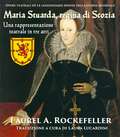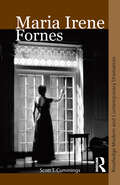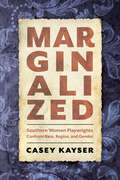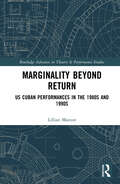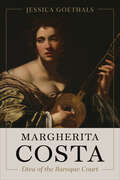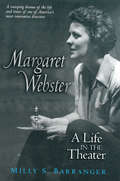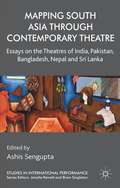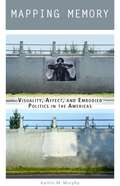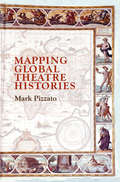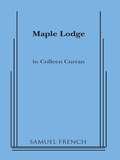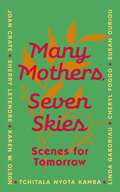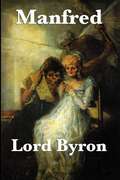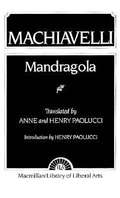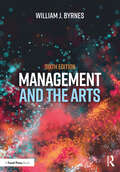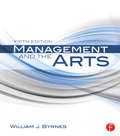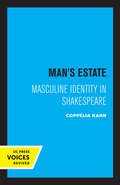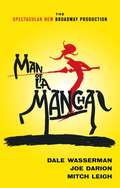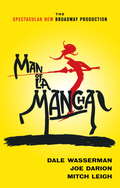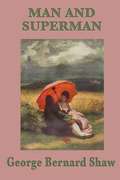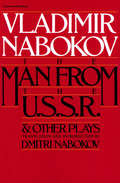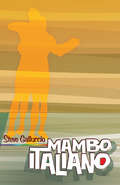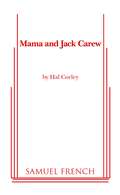- Table View
- List View
Maria Stuarda, regina di Scozia: una rappresentazione teatrale in tre atti
by Laurel A. Rockefeller Laura LucardiniLa tragica storia della regina Maria Stuarda diventa un'opera teatrale in questa coinvolgente tragedia che ne racconta la vita, gli amori e il regno. Un'opera perfetta per le scuole e le compagnie amatoriali. Include bibliografia e cronologia degli eventi. Durata: 60-80 minuti.
Maria Irene Fornes (Routledge Modern and Contemporary Dramatists)
by Scott T. CummingsMaria Irene Fornes is the most influential female American dramatist of the 20th century. That is the argument of this important new study, the first to assess Fornes's complete body of work. Scott T. Cummings considers comic sketches, opera libretti and unpublished pieces, as well as her best-known plays, in order to trace the evolution of her dramaturgy from the whimsical Off-Off Broadway plays of the 1960s to the sober, meditative work of the 1990s. The book also reflects on her practice as an inspirational teacher of playwriting and the primary director of her own plays. Drawing on the latest scholarship and his own personal research and interviews with Fornes over two decades, Cummings examines Fornes's unique significance and outlines strategies for understanding her fragmentary, enigmatic, highly demanding theater.
Marginalized: Southern Women Playwrights Confront Race, Region, and Gender
by Casey KayserWinner of the 2021 Eudora Welty PrizeIn contrast to other literary genres, drama has received little attention in southern studies, and women playwrights in general receive less recognition than their male counterparts. In Marginalized: Southern Women Playwrights Confront Race, Region, and Gender, author Casey Kayser addresses these gaps by examining the work of southern women playwrights, making the argument that representations of the American South on stage are complicated by difficulties of identity, genre, and region. Through analysis of the dramatic texts, the rhetoric of reviews of productions, as well as what the playwrights themselves have said about their plays and productions, Kayser delineates these challenges and argues that playwrights draw on various conscious strategies in response. These strategies, evident in the work of such playwrights as Pearl Cleage, Sandra Deer, Lillian Hellman, Beth Henley, Marsha Norman, and Shay Youngblood, provide them with the opportunity to lead audiences to reconsider monolithic understandings of northern and southern regions and, ultimately, create new visions of the South.
Marginality Beyond Return: US Cuban Performances in the 1980s and 1990s (Routledge Advances in Theatre & Performance Studies)
by Lillian ManzorThis study is an exploration of US Cuban theatrical performances written and staged primarily between 1980 and 2000. Lillian Manzor analyzes early plays by Magali Alabau, Jorge Ignacio Cortiñas, María Irene Fornés, Eduardo Machado, Manuel Martín Jr., and Carmelita Tropicana as well as these playwrights’ participation in three foundational Latine theater projects --INTAR’s Hispanic Playwrights-in-Residence Laboratory in New York (1980-1991), Hispanic Playwrights Project at South Coast Repertory Theater in Costa Mesa, CA (1986-2004), and The Latino Theater Initiative at Center Theater Group's Mark Taper Forum in Los Angeles (1992-2005). She also studies theatrical projects of reconciliation among Cubans on and off the island in the early 2000s. Demonstrating the foundational nature of these artists and projects, the book argues that US Cuban theater problematizes both the exile and Cuban-American paradigms. By investigating US Cuban theater, the author theorizes via performance, ways in which we can intervene in and reformulate political and representational positionings within the context of hybrid cultural identities. This book will of great interest to students and scholars in Performance Studies, Transnational Latine Studies, Race and Gender studies.
Margherita Costa, Diva of the Baroque Court (Toronto Italian Studies)
by Jessica GoethalsThe Roman singer, courtesan, and writer Margherita Costa won prominence and fame across the courts of Italy and France during the mid-seventeenth century. She secured a steady stream of elite patrons – including popes, queens, grand dukes, and influential cardinals – while male poets and librettists wrote celebratory poetry on her behalf. In addition to her appearances as a soprano on the opera stage, Costa published a remarkable fourteen full-length texts across an expanse of genres: burlesque comedy, drama, equestrian ballet, pastoral opera, amorous letters, lyric poetry, and history. Margherita Costa, Diva of the Baroque Court brings together close textual readings of Costa’s numerous publications with archival materials detailing her performance itinerary and social-cultural networks. The book progresses chronologically through her life, geographically along the routes she travelled, and thematically via the genres in which she experimented. Jessica Goethals illuminates how Costa was unafraid to leap over the boundaries of decorum that delimited what women should and did write about. More than merely a literary biography, this book is also a portrait of seventeenth-century courts, their concerns, and their entertainments.
Margaret Webster: A Life in the Theater
by Milly S. BarrangerMargaret Webster: A Life in the Theater is an engrossing backstage account of the life of pioneering director Margaret Webster (1905-72). This is the first book-length biography of Webster, a groundbreaking stage and opera director whose career challenged not only stage tradition but also mainstream attitudes toward professional women. Often credited with first having brought Shakespeare to Broadway, and renowned for her bold casting of an African American (Paul Robeson) in the role of Othello, Webster was a creative force in modern American and British theater. Her story reveals the independent-minded artist undeterred by stage tradition and unmindful of rules about a woman's place in the professional theater. In addition to providing fascinating glimpses into Webster's personal and family life, Margaret Webster: A Life in the Theater also offers a who's-who list of the biggest names in New York and London theater of the time, as well as Hollywood: John Gielgud, Noël Coward, George Bernard Shaw, Uta Hagen, Sybil Thorndike, Eva LeGallienne, and John Barrymore, among others, all of whom crossed paths with Webster. Capping Webster's amazing story is her investigation by Senator Joseph McCarthy and HUAC, which left her unable to work for a year, and from which she never fully recovered.
Mapping South Asia through Contemporary Theatre
by Ashis SenguptaWhile remapping the region by examining enduring historical and cultural connections, this study discusses multiple traditions and practices of theatre and performance in five South Asian countries within their specific political and socio-cultural contexts.
Mapping Memory: Visuality, Affect, and Embodied Politics in the Americas
by Kaitlin M. MurphyIn Mapping Memory, Kaitlin M. Murphy investigates the use of memory as a means of contemporary sociopolitical intervention. Mapping Memory focuses specifically on visual case studies, including documentary film, photography, performance, new media, and physical places of memory, from sites ranging from the Southern Cone to Central America and the U.S.–Mexican borderlands. Murphy develops new frameworks for analyzing how visual culture performs as an embodied agent of memory and witnessing, arguing that visuality is inherently performative. By analyzing the performative elements, or strategies, of visual texts—such as embodiment, reenactment, haunting, and the performance of material objects and places Murphy elucidates how memory is both anchored in and extracted from specific bodies, objects, and places. Drawing together diverse theoretical strands, Murphy originates the theory of “memory mapping”, which tends to the ways in which memory is strategically deployed in order to challenge official narratives that often neglect or designate as transgressive certain memories or experiences. Ultimately, Murphy argues, memory mapping is a visual strategy to ask, and to challenge, why certain lives are rendered visible and thus grievable and others not.
Mapping Irish Theatre
by Shaun Richards Chris MorashSeamus Heaney once described the 'sense of place' generated by the early Abbey theatre as the 'imaginative protein' of later Irish writing. Drawing on theorists of space such as Henri Lefebvre and Yi-Fu Tuan, Mapping Irish Theatre argues that theatre is 'a machine for making place from space'. Concentrating on Irish theatre, the book investigates how this Irish 'sense of place' was both produced by, and produced, the remarkable work of the Irish Revival, before considering what happens when this spatial formation begins to fade. Exploring more recent site-specific and place-specific theatre alongside canonical works of Irish theatre by playwrights including J. M. Synge, Samuel Beckett and Brian Friel, the study proposes an original theory of theatrical space and theatrical identification, whose application extends beyond Irish theatre, and will be useful for all theatre scholars.
Mapping Global Theatre Histories
by Mark PizzatoThis textbook provides a global, chronological mapping of significant areas of theatre, sketched from its deepest history in the evolution of our brain's 'inner theatre' to ancient, medieval, modern, and postmodern developments. It considers prehistoric cave art and built temples, African trance dances, ancient Egyptian and Middle-Eastern ritual dramas, Greek and Roman theatres, Asian dance-dramas and puppetry, medieval European performances, global indigenous rituals, early modern to postmodern Euro-American developments, worldwide postcolonial theatres, and the hyper-theatricality of today's mass and social media. Timelines and numbered paragraphs form an overall outline with distilled details of what students can learn, encouraging further explorations online and in the library. Questions suggest how students might reflect on present parallels, making their own maps of global theatre histories, regarding geo-political theatrics in the media, our performances in everyday life, and the theatres inside our brains.
Maple Lodge
by Colleen CurranFull Length, Comedy / 2 m., 3 f. / Heather, Dennis and Tara are opening their cottage, Maple Lodge, for the summer and are expecting their formidable mother. The three a college administrator, a pharmacist and a twice divorced TV anchor woman have been coming to Maple Lodge all of their lives and Tara assures everyone that this summer will be the same as always once this weekend is over. She is wrong. Everything changes with the arrival an exotic stranger. In the meantime, Mother has won a Suitcase Dance to Mexico and will miss the big event Tara is hosting: the raising of a covered bridge to replace the beloved one burned to the ground by the Kingman brothers twenty five years ago. Her co chairman on the bridge committee, a local lumberman, just happens to be in love with Heather. Maple Lodge has kept many secrets, but they all come out this weekend. / Winner of the Samuel French Canadian Playwrights Contest.
Many Mothers, Seven Skies: Scenes for Tomorrow
by Joan Crate Cheryl Foggo Tchitala Nyota KambaA diverse group of seven writers comes together to create seven tender scenes about their hopes for the future."The seven of us, a diverse group of elders, have endured, loved, lost and celebrated life in our own ways. Now, we decided, we would write a production for the stage, voicing our different experiences and what we came to realize are similar concerns about the future of our families, our planet, its peoples and its incredible network of flora and fauna."The Many Mothers Collective came together during the pandemic, hoping to make sense of the world that they found themselves in. What they found is that they needed to focus not only on the present moment, but on the world they would leave for their children and grandchildren -- and for seven generations into the future. In seven scenes for the stage, they explore where we have come from and where we are going, with a deep hopefulness rooted in resistance.
Manonmaneeyam
by P. Sundaram Pillai"Manonmaneeyam" tells us about the harm done by the wicked to the good, and how ultimately the good emerges victorious. This play is unique in the sense that, like English plays, it is divided into Acts and Scenes.
Manfred
by Lord ByronManfred, a Faustian noble, is tortured by guilt over the death of his beloved, Astarte. He uses his mastery of language and spell-casting to summon seven spirits, from whom he seeks forgetfulness. The spirits are unable to control the past and thus cannot grant Manfred's plea.
Mandragola
by Niccolo Machiavelli Anne Paolucci Henry PaolucciWritten somewhere between 1512 and 1520, this is a comedic play in which a love stuck young man tries to win the affections of the young, beautiful wife of an old doctor.
Management and the Arts
by William J. ByrnesThe sixth edition of Management and the Arts has been revised and updated with the latest concepts, theories, and practices to meet the evolving demands faced by arts managers in cultural organizations around the world. This comprehensive textbook covers a wide range of topics, including planning, strategy development, leading, marketing, fundraising, budgeting, finance, staffing, and operations. The book takes an interdisciplinary approach as it explores how arts managers and leaders can develop equitable, collaborative, and dynamic organizations that bring communities together to experience all the arts have to offer. It also includes illustrations, tables, tools, techniques, and case studies that can be applied in a wide range of visual and performing arts organizations. Each chapter features terms, learning outcomes, real world examples, and discussion questions designed to help students build skills, develop strategies, and understand options to consider in meeting the challenges faced by cultural organizations. New to this edition: An extensive focus on how arts managers and organizations can successfully engage in developing and implementing equity, diversity, and inclusion programs Expanded content on leadership, marketing, social media, and fundraising theories, practices, and ethics Updated content about planning and assessment, business models, entrepreneurship, and heuristics Expanded coverage of organizational culture and its impact on programming, operations, and inclusion Additional perspectives about leading in the arts, examination of theories of motivation and communication, and expanded discussion on leadership ethics Integration of topics on operations, budgeting, and finance including technology and CRM systems Suggested additional readings, website links, and a broad array of other resources have been carefully gathered to help faculty guide students of Performing Arts programs and Arts Management courses as they explore what is required to work with artists, board members, staff, funders, volunteers, and community leaders. Management and the Arts includes access to a companion website featuring a sample syllabus, additional project assignments, suggested resources, and chapter-by-chapter PowerPoint slides (www.managementandthearts.com).
Management and the Arts
by William James ByrnesThe fifth edition of Management and the Arts provides you with theory and practical applications from all arts management perspectives including planning, marketing, finance, economics, organization, staffing, and group dynamics. Regardless of whether you are a manager in a theatre, museum, dance company, or opera, you will gain useful insights into strategic planning, organization, and integrated management theories. Case studies, statistics, and real-world examples will allow you get a handle on all aspects of arts managements, from budgeting and fundraising, to e-marketing and social networking, to working effectively with boards and staff members. Revised to reflect the latest thinking and trends in managing organizations and people, this fifth edition features class-tested questions in each chapter, which help you to integrate the material and develop ideas about how the situations and problems could have been handled. Case studies focus on the challenges facing managers and organizations every day, and "In the News" quotes give you real-world examples of principles and theories.
Man's Estate: Masculine Identity in Shakespeare
by Coppelia H. KahnThis title is part of UC Press's Voices Revived program, which commemorates University of California Press’s mission to seek out and cultivate the brightest minds and give them voice, reach, and impact. Drawing on a backlist dating to 1893, Voices Revived makes high-quality, peer-reviewed scholarship accessible once again using print-on-demand technology. This title was originally published in 1981.
Man of La Mancha: A Musical Play
by Dale WassermanThis is a powerful story of a man, disillusioned with everyday life, who decides to become a Knight Errant and go out forth into the world righting all wrongs.
Man of La Mancha
by Dale WassermanWinner of the New York Drama Critics Award for Best Musical, 1966"To me the most interesting aspect of the success of Man of La Mancha is the fact that it plows squarely upstream against the prevailing current of philosophy in the theater. That current is best identified by its catch-labels--Theater of the Absurd, Black Comedy, the Theater of Cruelty--which is to say the theater of alienation, of moral anarchy and despair. To the practitioners of those philosophies Man of La Mancha must seem hopelessly naive in its espousal of illusion as man's strongest spiritual need, the most meaningful function of his imagination. But I've no unhappiness about that. "Facts are the enemy of truth," says Cervantes-Don Quixote. And that is precisely what I felt and meant."--Dale Wasserman, from the Preface.From the Trade Paperback edition.
Man and Superman
by George Bernard ShawOne of Shaw's finest and most devilish comedies, Man and Superman portrays Don Juan as the quarry instead of the huntsman. John Tanner, upon discovering that his beautiful ward plans to marry him, flees to the Sierra Nevada mountain range, where he is captured by a group of rebels. Tanner falls asleep, and dreams the famous "Don Juan in Hell" sequence, which features a sparkling Shavian debate among Don Juan, the Devil, and a talkative statue. With its fairy-tale ending and a cast literally from hell, Man and Superman is a hilarious cocktail of farce, Nietzschean philosophy, and Mozart's Don Giovanni.
Man From The USSR & Other Plays: And Other Plays
by Vladimir NabokovFour plays and two essays on drama, written during Nabokov's émigré years before his writings in English earned him worldwide fame. Translated and with Introductions by Dmitri Nabokov.
Mambo Italiano
by Steve GalluccioMambo Italiano achieves its overwhelming power through a perfect balance of fast-paced comedy and poignant drama. Angelo, at the prompting of his equally repressed sister Anna, has told his very traditionally Italian immigrant parents, Maria and Gino, that he is gay. Hurt, betrayed and mortified by Angelo's coming out, his lover Nino is not unprepared for his widowed Italian mother Lina's reaction--a full-on operatic barrage of melodrama and hysterical excess so profound it gives even Angelo's shocked parents pause for second thoughts and prompts a hilarious and touching re-examination of their own outraged response to their son. Seeing their relationship shattered by their families' reactions of grotesquely overplayed comedy and pathos, Angelo emerges from the drama with his new-found pride intact, while Nino retreats even further into the darkness of his bisexual closet. While the press has often called the film version of Mambo Italiano "a gay My Big Fat Greek Wedding," there is far more at work in the play than the zealous mining of Italian immigrant family and gay culture stereotypes. Translated by Michel Tremblay, its huge fan, into a wildly successful Francophone theatrical phenomenon, Mambo Italiano is far more about the dynamics of family, about the vast spaces between the old world and the new, about grasping the resonant codes embedded in what is said and what is meant in ordinary speech, than it is "about" gay culture. In perhaps the play's most defining scene, the parish priest has been bribed with a bottle of wine and a carton of cigarettes to vacate his confessional so it can be occupied by the members of Angelo's family to ritually unburden themselves of their hilarious sins of personal hypocrisy, willful misapprehension and thoughtless transgression. Cast of 4 women and 3 men.
Mama and Jack Carew
by Hal CorleyDramatic Comedy / 2m, 1f / Unit Set In the summer of 1969, Beau Stanley's last hurrah before heading off to study architecture in college, doting Mama Lillian vows to help him finally lose his baby fat. Armed with a supply of diet pills and a food-free regimen that includes tearing down a family room wall, 3 a.m. trips to Dulles Airport and blazing, amphetamine-fueled days on the beach, mother and son spend a memorable vacation together. But Beau's weight loss isn't restless Lillian's only project, and in an unguarded moment, she reveals her just-begun affair with a travelling defense contractor, Jack Carew. Once Lillian introduces son and lover, Beau's caught in the oedipal crossfire of a covert and explosive new alliance, forced to cover his Mama's many absences from home. Over the next decade, Jack's repeated pledge to end his own loveless marriage and sweep Lillian away proves a hollow promise. As increasingly beleaguered Beau sacrifices his own independence to help his mother confront her disillusionment and finally, betrayal, parent-child roles are turned upside down. Mama and Jack Carew is a harrowing, oftentimes black-comedic portrait of an unlikely triangle.
